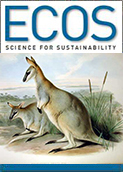
|
Published: 15 October 2014
Pause for hope: de-carbonisation could halve CO2 emissions and enhance prosperity by 2050
‘Hey, only the fate of humanity is at stake’, read a hand-written placard at the recent People’s Climate March in New York that attracted more than 300,000 people. It was not the only sign that indicated public despair. But it’s not too late to do something.

|
|
The People’s Climate March, New York, September 2014: Researchers say countries around the world can still limit global warming to 2°C to avoid the worst climate change risks and impacts by working together to ‘decarbonise’ the global economy. Credit: Moms Clean Air Force under CC BY-NC-SA 2.0
|
Humanity can cut its carbon emissions by half by mid-century, using known technologies, and without compromising prosperity.
That’s the message presented by a project partnership embracing 15 countries, including Australia, at the recent UN climate summit in New York.
The Deep Decarbonisation Pathways project involves research teams from countries with high emission levels – Brazil, Canada, China, France, Germany, India, Indonesia, Japan, Mexico, Russia, South Africa, South Korea, the UK, and the USA, as well as Australia. Between them, these countries account for 70 per cent of the world’s greenhouse gas emissions.
The aim of the project is to show how the world can still limit global warming to 2°C to avoid the worst climate change risks and impacts. The focus is on cutting emissions within each country, not on trading of offset credits.
Our scenario modelling suggests Australia could cut domestic energy emissions by 80 per cent by 2050; carbon forestry could bring the balance down to zero, with Australia staying within the carbon budget for a 2°C temperature rise. All this while our GDP continues to grow at the current 5-year average, with growth in mining, manufacturing and agriculture and forestry.
How is that possible? By using the same three ‘pillars’ for decarbonisation that have been applied by the 14 other countries:
-
save energy by improving equipment and processes
-
shift direct use of gas, oil and coal to electricity, and
-
take the carbon out of electricity supply.
A de-carbonised electricity supply might be based almost 100 per cent on renewable energy; or renewables plus nuclear or carbon capture and storage. When the wind doesn’t blow and the sun doesn’t shine, molten salt in solar thermal power stations could provide storage, as could batteries. Bioenergy could also help replace fossil fuels.
Sound like a fantasy? Not any more. With technology developing at a rate of knots and costs coming down, much more is possible now than even a decade ago. Imagine what would be possible next decade if action was taken today; with what we know about today’s technologies, we could easily have a carbon-free energy sector.
The news gets better. If the world as a whole takes action – and this has been a prerequisite for very strong climate action by Australia’s government – there is every chance that Australia will emerge with a strong energy and resources sector.
Australia is an energy superpower, no matter what the preferred form of energy is. Just as we have massive amounts of coal, we also have huge opportunities for low carbon energy sources. We have unlimited amounts of readily accessible renewable energy sources, as well as plentiful uranium deposits and geologically stable storage sites for carbon and radioactive waste. These resources could fuel the emissions-intensive manufacturing and mining sectors of the future.
Would such a shift be unaffordable and play havoc with the economy? Again: no.
In our scenario, based on state-of-the-art models that the Australian Government used previously in its own analyses, the national economy would grow by 150 per cent to 2050, while net emissions fell to zero. And this is before we include other likely economic benefits associated with decarbonisation, such as decreased health costs and improved energy productivity.
Our analysis shows that deep decarbonisation requires neither substantial lifestyle changes nor large changes in Australia’s economic structure. There would be deep technological change in some industries and decline in a few, but others would rise in turn.
The costs of zero-carbon technologies have come down, in some cases dramatically. Today, solar panels cost just 10 per cent of what they did in 1980 and half their 1998 cost, and costs are still falling.
We took a hard look at opportunities to cut emissions in industry, buildings and transport, and for opportunities to sequester carbon in trees. What we found were plentiful opportunities to get to a very low-carbon future – if we take an integrated approach, invest in R&D, and foster the commercial uptake of technologies.
None of this is to belittle the task on hand: the need for the world to take strong climate action. Such action would be a significant transition for Australia, and would need to be well managed.
But the experience of previous generations facing far-reaching economic change – such as the transition from mainly agricultural to mainly mining-based exports, and the rise of Australia’s service industry – has shown that we as a nation have the flexibility, adaptability, and resilience to adapt.
The other 14 teams who prepared their national trajectories for the New York climate summit also demonstrated that emissions would come down drastically in developed countries.
China is perhaps the most striking example. The Chinese modelling showed emissions peaking before 2030, and falling to one-third of present levels by 2050 – all while the nation continues to modernise, and pull hundreds of millions of people from rural poverty into relatively affluent urban lives. Low-emissions technologies enable it.
So, there’s no reason for despair. But we will need to set our collective sights beyond our 5 per cent national emissions reduction target by 2020. Next year, all countries will need to put emissions targets for 2025 or 2030 on the negotiating table. It’s an opportunity for Australia to take stock and ask, where could we be in 2050, and what do we need to do to get there?
Associate Professor Frank Jotzo is Director, Centre of Climate Economics and Policy at Australian National University, and Anna Skarbek is Executive Director, ClimateWorks Australia. The Australian National University and ClimateWorks Australia have been appointed by the UN Sustainable Development Solution Network to lead the Deep Decarbonisation Pathways Project in Australia. You can download a copy of the report, Pathways to Deep Decarbonisation in 2050: How Australia can prosper in a low carbon world here.



